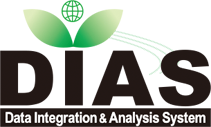


  |  |
| Name | JRA55-JMACPS2-Delta-S14FD reanalysis-forecast combined meteorological forecing dataset |
| Edition | version 1.0 |
| Abbreviation | JCDS |
| DOI | doi:10.20783/DIAS.649 |
| Metadata Identifier | JRA55_JMACPS2_Delta_S14FD20250514152038-DIAS20221121113753-en |
| Name | Toshichika Iizumi |
|---|---|
| Organization | Institute for Agro-Environmental Sciences, National Agriculture and Food Research Organization |
| Address | 3-1-3 Kannondai, Tsukuba, Ibaraki, 305-8604, Japan |
| TEL | 029-838-8201 |
| iizumi.toshichika765@naro.go.jp |
| Name | DIAS Office |
|---|---|
| Organization | Japan Agency for Marine-Earth Science and Technology |
| Address | 3173-25, Showa-Cho, Kanazawa-ku, Yokohama-shi, Kanagawa, 236-0001, Japan |
| dias-office@diasjp.net |
| Name | Toshichika Iizumi |
|---|---|
| Organization | Institute for Agro-Environmental Sciences, National Agriculture and Food Research Organization |
| iizumi.toshichika765@naro.go.jp |
| Name | Toshichika Iizumi |
|---|---|
| Organization | Institute for Agro-Environmental Sciences, National Agriculture and Food Research Organization |
| iizumi.toshichika765@naro.go.jp |
creation : 2022-10-26
The JRA55-JMACPS2-Delta-S14FD is a global 0.5°-resolution bias-corrected reanalysis-forecast combined daily meteorological forcing dataset. For the reanalysis part, JRA-55 provided by the Japan Meteorological Agency (JMA) was used after aggregating its 3-hourly values into daily values. Daily outputs from the JMA/MRI-CPS2 forecast system were used for the forecast part of the combined dataset. The reanalysis and forecast values were respectively bias-corrected and then combined on a common baseline climatology. The S14FD meteorological forcing dataset was used as the baseline. The delta method was used for the bias correction. The delta method was applied differently depending on the weather variables (additively for temperature, humidity, radiation, and pressure and multiplicatively for precipitation and wind speed).
After the bias correction, calculated relative changes in the reanalysis and forecast values, relative to each climatology, were combined onto the climatology of the meteorological forcing to produce a daily time series for three years per combining date. A 3-year period spans from January 1 of the year before the combining date (t-1) to December 31 of the year after (t+1) of the combining data. The reanalysis data are used before the combining date, and then it is assigned the forecast data for about 240 days after the combining date, and the climatology of baseline meteorological forcing after that. The delta method is used in the bias correction. The combining dates are 13 cases, 30 days apart, beginning from January 10 (denoted as 0110) to December 6th (denoted as 1206), namely 0110, 0209, 0301, 0331, 0430, 0530, 0629, 0729, 0828, 0927, 1007, 1106, and 1206. The combined data are available for each of the combining dates from 2010 to 2021. Note that if the combining date is January 10th, 2010, the three-year period of the combined data starts from January 1st, 2009 to December 31st, 2011. Similarly, if the combining date is December 6th, 2021, the 3-year period spans from January 1st, 2020 to December 31st, 2022.
The weather variables include daily mean, maximum and minimum 2m air temperature (tave2m, tmax2m, tmin2m; °C), daily total precipitation (precsfc, mm d-1), downward shortwave and long radiation flux (dswrfsfc, dlwrfsfc; W m-2), 2m relative and specific humidity (rh2m, %; and spfh2m, kg kg-1), 10m wind speed (wind10m, m s-1), and surface pressure (pressfc, hPa).
climatologyMeteorologyAtmosphere
| Begin Date | 2010-01-01 |
| End Date | 2021-12-31 |
| Temporal Characteristics | Daily |
| North bound latitude | 90 |
| West bound longitude | -180 |
| Eastbound longitude | 180 |
| South bound latitude | -90 |
| Dimension Name | Dimension Size (slice number of the dimension) | Resolution Unit |
|---|---|---|
| row | 720 | 0.5 (deg) |
| column | 360 | 0.5 (deg) |
| Keyword Type | Keyword | Keyword thesaurus Name |
|---|---|---|
| theme | Atmosphere > Atmospheric Temperature > Surface Air Temperature, Atmosphere > Precipitation > Precipitation Rate, Atmosphere > Atmospheric Radiation > Shortwave Radiation, Atmosphere > Atmospheric Water Vapor > Humidity, Atmosphere > Atmospheric Winds > Surface Winds > , Atmosphere > Atmospheric Pressure > Surface Pressure, Atmosphere > Atmospheric Radiation > Longwave Radiation | GCMD_science |
| Keyword Type | Keyword | Keyword thesaurus Name |
|---|---|---|
| theme | DIAS > Data Integration and Analysis System | No_Dictionary |
file download : https://data.diasjp.net/dl/storages/filelist/dataset:649
| name | version | specification |
|---|---|---|
| NetCDF | 4 |
In this combined meteorological forcing dataset, the JRA-55 reanalysis and the JMA/MRI-CPS2 forecast are bias-corrected for the S14FD meteorological forcing, respectively, and then combined to be a single daily time series. The reanalysis data are used before the combining date, the forecast data for about 240 days after the combining date, and the climatology of baseline meteorological forcing after that. The delta method is used in the bias correction.
If data are used, the relevant reference(s) or dataset DOI should be cited. For the reference(s), see the References section.
If data provider does not have data policy, DIAS Terms of Service (https://diasjp.net/en/terms/) and DIAS Privacy Policy (https://diasjp.net/en/privacy/) apply.
If there is a conflict between DIAS Terms of Service and data provider's policy, the data provider's policy shall prevail.
 CC-BY 4.0 :
Creative Commons Attribution 4.0 International
CC-BY 4.0 :
Creative Commons Attribution 4.0 International
No acknowledgement is required.
If you plan to use this dataset for a conference presentation, paper, journal article, or report etc., please include acknowledgments referred to following examples. If the data provider describes examples of acknowledgments, include them as well.
" In this study, [Name of Dataset] provided by [Name of Data Provider] was utilized. This dataset was also collected and provided under the Data Integration and Analysis System (DIAS), which was developed and operated by a project supported by the Ministry of Education, Culture, Sports, Science and Technology. "
Iizumi, T., T. Takimoto, Y. Masaki, A. Maruyama, N. Kayaba, Y. Takaya, and Y. Masutomi (2024) A hybrid reanalysis-forecast meteorological forcing data for advancing climate adaptation in agriculture. Scientific Data, 11, 849. https://doi.org/10.1038/s41597-024-03702-5